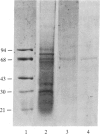Abstract
Synthesis of the cytolytic C9-related protein (C9RP) was induced by activation of resting human peripheral T lymphocytes with the anti-CD3 antibody OKT3 or interleukin 2. Comparison of cellular cytotoxicity and C9RP content at various times during activation yielded a coefficient of correlation r = 0.92. During OKT3 stimulation of peripheral mononuclear cells, maximal C9RP content and cytotoxicity were observed by day 2 or 3, with subsequent decline to baseline values by day 5, whereas during interleukin 2 stimulation, both parameters reached the maximal level at days 3-5. After fluorescence-activated cell sorting, C9RP and cytotoxicity were quantitated in CD4+, CD8+, and Leu-19+ subsets. In OKT3-activated CD8+ cells, C9RP increased to approximately 3 X 10(6) molecules per cell, with a corresponding increase in lysis of human melanoma cells mediated by anti-CD3-anti-melanoma monoclonal antibody conjugates. Interleukin 2-stimulated CD8+ cells showed similar increases, but cytotoxicity was conjugate-independent. Activated CD4+ cells showed minimal increase in C9RP content. Leu-19+ cells, which exhibit natural killer cell activity, had a high C9RP content (approximately 2.5 X 10(6) molecules per cell) before stimulation.
Full text
PDF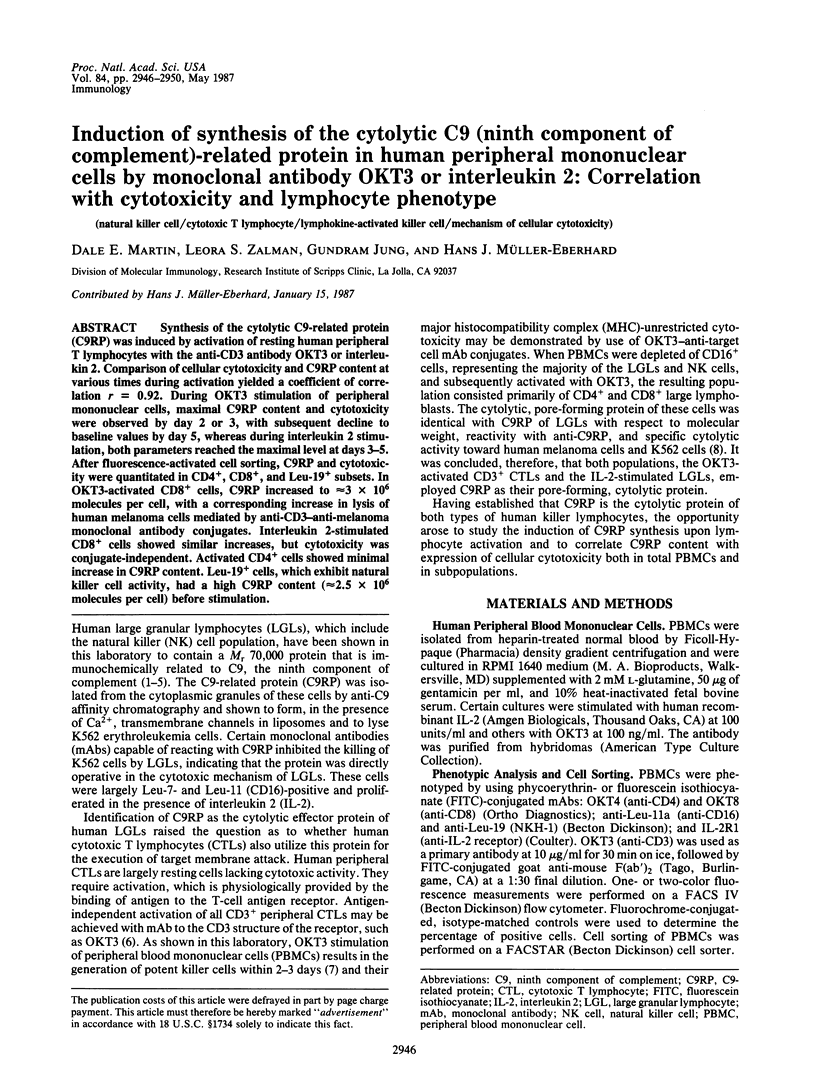
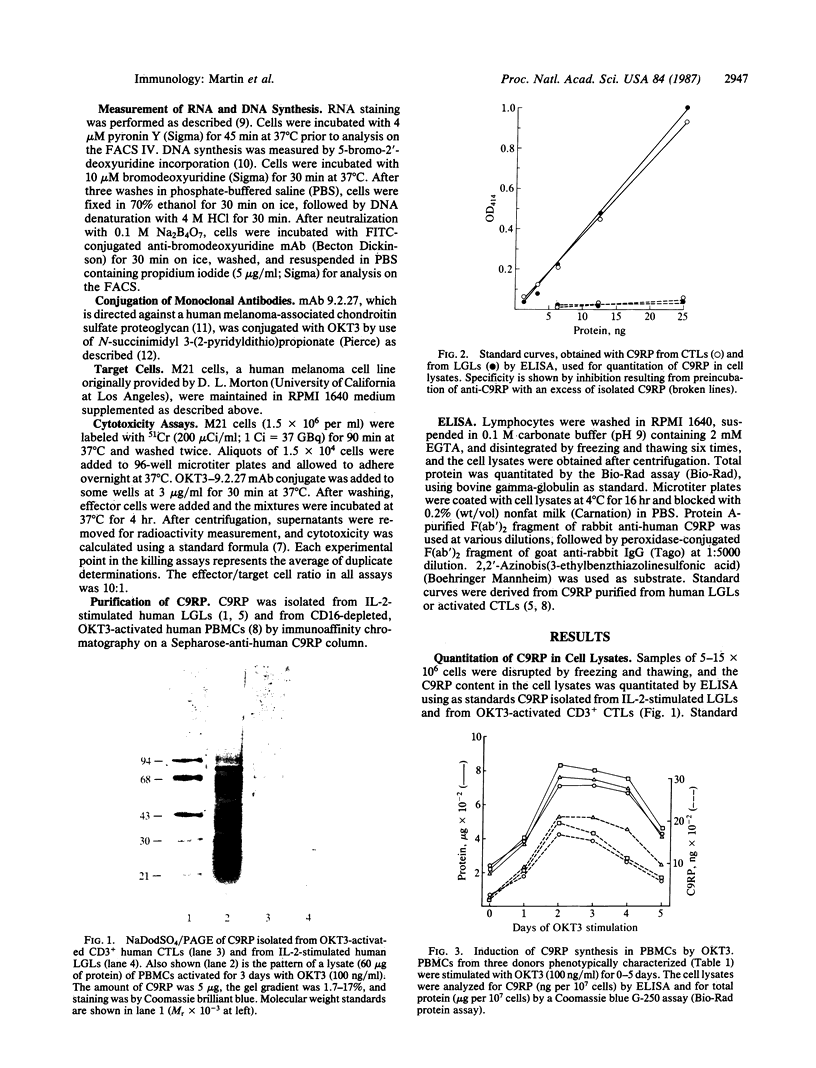
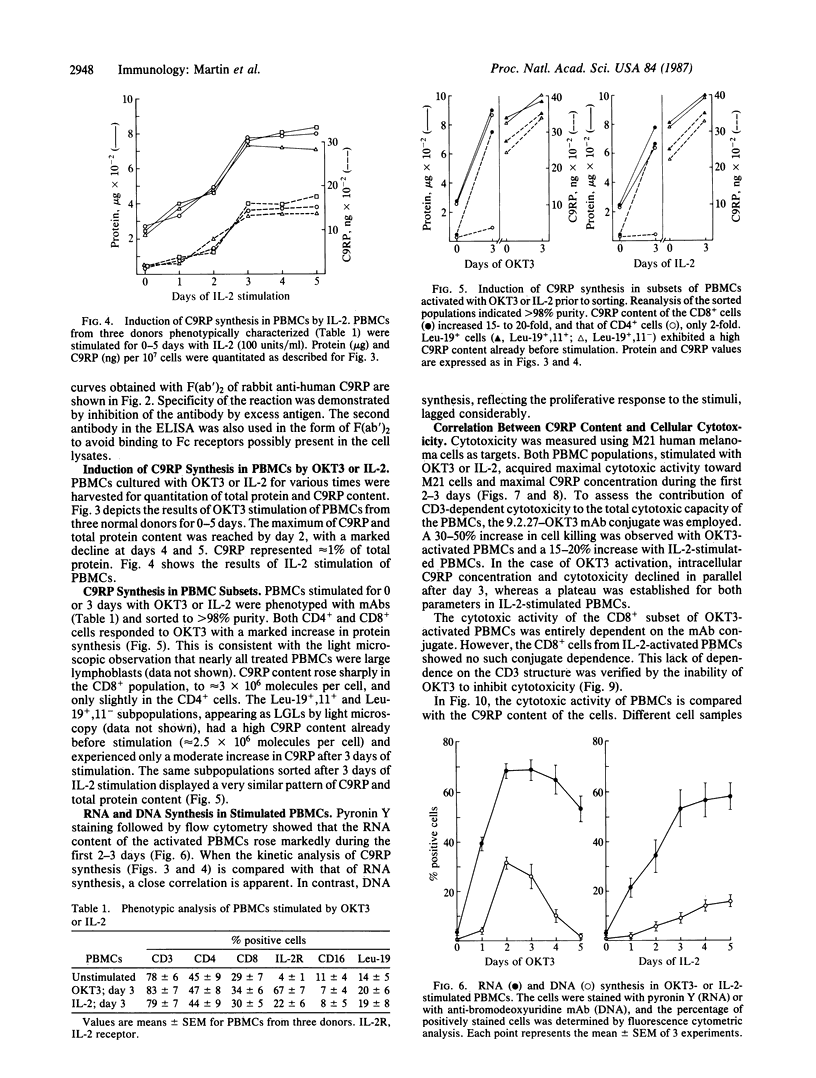
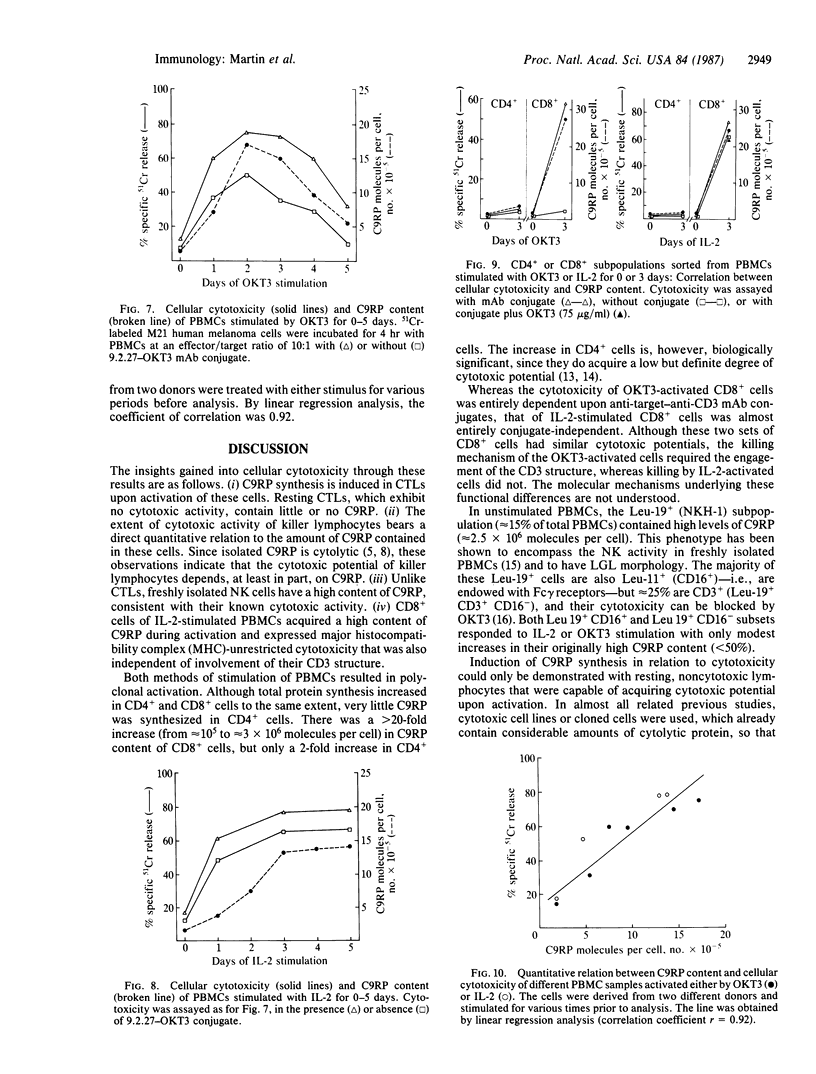
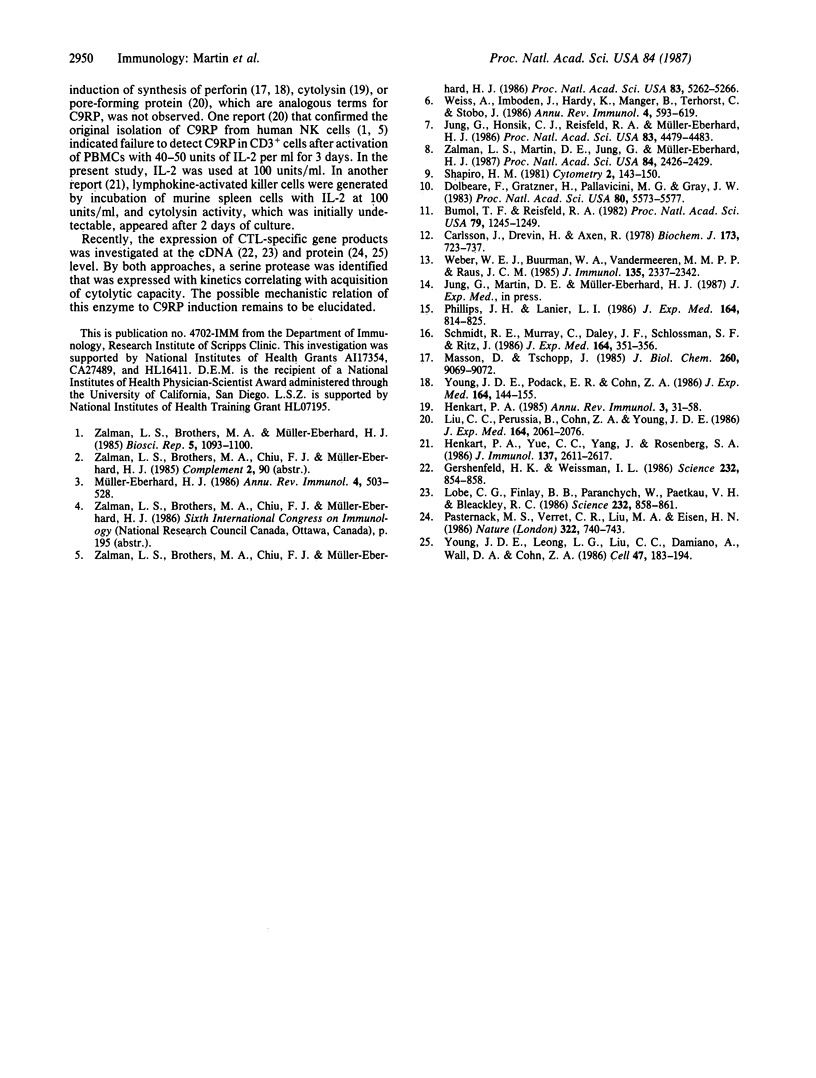
Images in this article
Selected References
These references are in PubMed. This may not be the complete list of references from this article.
- Bumol T. F., Reisfeld R. A. Unique glycoprotein-proteoglycan complex defined by monoclonal antibody on human melanoma cells. Proc Natl Acad Sci U S A. 1982 Feb;79(4):1245–1249. doi: 10.1073/pnas.79.4.1245. [DOI] [PMC free article] [PubMed] [Google Scholar]
- Carlsson J., Drevin H., Axén R. Protein thiolation and reversible protein-protein conjugation. N-Succinimidyl 3-(2-pyridyldithio)propionate, a new heterobifunctional reagent. Biochem J. 1978 Sep 1;173(3):723–737. doi: 10.1042/bj1730723. [DOI] [PMC free article] [PubMed] [Google Scholar]
- Dolbeare F., Gratzner H., Pallavicini M. G., Gray J. W. Flow cytometric measurement of total DNA content and incorporated bromodeoxyuridine. Proc Natl Acad Sci U S A. 1983 Sep;80(18):5573–5577. doi: 10.1073/pnas.80.18.5573. [DOI] [PMC free article] [PubMed] [Google Scholar]
- Gershenfeld H. K., Weissman I. L. Cloning of a cDNA for a T cell-specific serine protease from a cytotoxic T lymphocyte. Science. 1986 May 16;232(4752):854–858. doi: 10.1126/science.2422755. [DOI] [PubMed] [Google Scholar]
- Henkart P. A. Mechanism of lymphocyte-mediated cytotoxicity. Annu Rev Immunol. 1985;3:31–58. doi: 10.1146/annurev.iy.03.040185.000335. [DOI] [PubMed] [Google Scholar]
- Henkart P. A., Yue C. C., Yang J., Rosenberg S. A. Cytolytic and biochemical properties of cytoplasmic granules of murine lymphokine-activated killer cells. J Immunol. 1986 Oct 15;137(8):2611–2617. [PubMed] [Google Scholar]
- Jung G., Honsik C. J., Reisfeld R. A., Müller-Eberhard H. J. Activation of human peripheral blood mononuclear cells by anti-T3: killing of tumor target cells coated with anti-target-anti-T3 conjugates. Proc Natl Acad Sci U S A. 1986 Jun;83(12):4479–4483. doi: 10.1073/pnas.83.12.4479. [DOI] [PMC free article] [PubMed] [Google Scholar]
- Liu C. C., Perussia B., Cohn Z. A., Young J. D. Identification and characterization of a pore-forming protein of human peripheral blood natural killer cells. J Exp Med. 1986 Dec 1;164(6):2061–2076. doi: 10.1084/jem.164.6.2061. [DOI] [PMC free article] [PubMed] [Google Scholar]
- Lobe C. G., Finlay B. B., Paranchych W., Paetkau V. H., Bleackley R. C. Novel serine proteases encoded by two cytotoxic T lymphocyte-specific genes. Science. 1986 May 16;232(4752):858–861. doi: 10.1126/science.3518058. [DOI] [PubMed] [Google Scholar]
- Masson D., Tschopp J. Isolation of a lytic, pore-forming protein (perforin) from cytolytic T-lymphocytes. J Biol Chem. 1985 Aug 5;260(16):9069–9072. [PubMed] [Google Scholar]
- Müller-Eberhard H. J. The membrane attack complex of complement. Annu Rev Immunol. 1986;4:503–528. doi: 10.1146/annurev.iy.04.040186.002443. [DOI] [PubMed] [Google Scholar]
- Pasternack M. S., Verret C. R., Liu M. A., Eisen H. N. Serine esterase in cytolytic T lymphocytes. Nature. 1986 Aug 21;322(6081):740–743. doi: 10.1038/322740a0. [DOI] [PubMed] [Google Scholar]
- Phillips J. H., Lanier L. L. Dissection of the lymphokine-activated killer phenomenon. Relative contribution of peripheral blood natural killer cells and T lymphocytes to cytolysis. J Exp Med. 1986 Sep 1;164(3):814–825. doi: 10.1084/jem.164.3.814. [DOI] [PMC free article] [PubMed] [Google Scholar]
- Schmidt R. E., Murray C., Daley J. F., Schlossman S. F., Ritz J. A subset of natural killer cells in peripheral blood displays a mature T cell phenotype. J Exp Med. 1986 Jul 1;164(1):351–356. doi: 10.1084/jem.164.1.351. [DOI] [PMC free article] [PubMed] [Google Scholar]
- Shapiro H. M. Flow cytometric estimation of DNA and RNA content in intact cells stained with Hoechst 33342 and pyronin Y. Cytometry. 1981 Nov;2(3):143–150. doi: 10.1002/cyto.990020302. [DOI] [PubMed] [Google Scholar]
- Weber W. E., Buurman W. A., Vandermeeren M. M., Raus J. C. Activation through CD3 molecule leads to clonal expansion of all human peripheral blood T lymphocytes: functional analysis of clonally expanded cells. J Immunol. 1985 Oct;135(4):2337–2342. [PubMed] [Google Scholar]
- Weiss A., Imboden J., Hardy K., Manger B., Terhorst C., Stobo J. The role of the T3/antigen receptor complex in T-cell activation. Annu Rev Immunol. 1986;4:593–619. doi: 10.1146/annurev.iy.04.040186.003113. [DOI] [PubMed] [Google Scholar]
- Young J. D., Leong L. G., Liu C. C., Damiano A., Wall D. A., Cohn Z. A. Isolation and characterization of a serine esterase from cytolytic T cell granules. Cell. 1986 Oct 24;47(2):183–194. doi: 10.1016/0092-8674(86)90441-1. [DOI] [PubMed] [Google Scholar]
- Young J. D., Podack E. R., Cohn Z. A. Properties of a purified pore-forming protein (perforin 1) isolated from H-2-restricted cytotoxic T cell granules. J Exp Med. 1986 Jul 1;164(1):144–155. doi: 10.1084/jem.164.1.144. [DOI] [PMC free article] [PubMed] [Google Scholar]
- Zalman L. S., Brothers M. A., Chiu F. J., Müller-Eberhard H. J. Mechanism of cytotoxicity of human large granular lymphocytes: relationship of the cytotoxic lymphocyte protein to the ninth component (C9) of human complement. Proc Natl Acad Sci U S A. 1986 Jul;83(14):5262–5266. doi: 10.1073/pnas.83.14.5262. [DOI] [PMC free article] [PubMed] [Google Scholar]
- Zalman L. S., Brothers M. A., Müller-Eberhard H. J. A C9 related channel forming protein in the cytoplasmic granules of human large granular lymphocytes. Biosci Rep. 1985 Dec;5(12):1093–1100. doi: 10.1007/BF01119631. [DOI] [PubMed] [Google Scholar]
- Zalman L. S., Martin D. E., Jung G., Müller-Eberhard H. J. The cytolytic protein of human lymphocytes related to the ninth component (C9) of human complement: isolation from anti-CD3-activated peripheral blood mononuclear cells. Proc Natl Acad Sci U S A. 1987 Apr;84(8):2426–2429. doi: 10.1073/pnas.84.8.2426. [DOI] [PMC free article] [PubMed] [Google Scholar]



